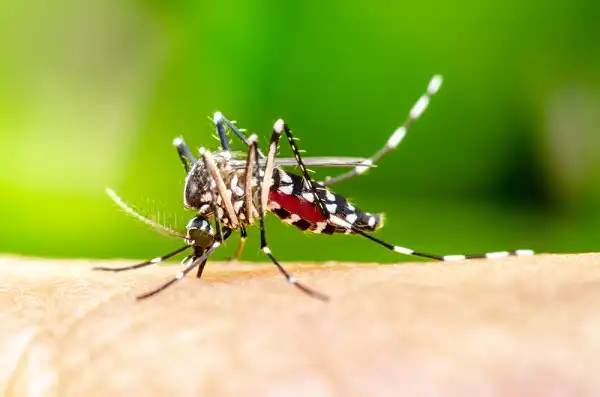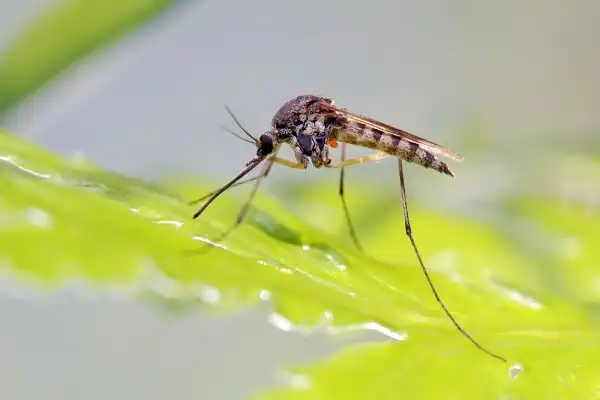Mosquitoes are some of the most irritating and annoying creatures on Earth. The buzzing sound they make, as well as their presence in our homes, can leave us feeling frustrated and even anxious. But what’s even more troubling is that mosquitoes can also carry a host of dangerous diseases like malaria and yellow fever, making them one of the leading causes of illness and death worldwide. In this blog post, we’ll examine how to protect yourself from getting bitten by mosquitoes and prevent the spread of these illnesses. We’ll also discuss natural remedies for mosquito bites as well as advice on controlling mosquito populations around your home. So if you’re looking for helpful tips on dealing with those pesky buggers – look no further!

Mosquito Description
Mosquitoes are small, flying insect that belongs to the family Culicidae. They are found in almost every part of the world, except in extremely cold areas such as Antarctica. Mosquitoes are known for their distinct long, thin legs, narrow wings, and annoying buzzing sound they make while flying. They typically feed on the blood of animals and humans, with the female mosquito being the main culprit due to her need for blood to lay eggs. Mosquitoes are not just irritating, but also quite dangerous. They are known to carry various diseases, including malaria, dengue, Zika, chikungunya, and yellow fever. In fact, mosquitoes are responsible for more deaths than any other living creature on the planet, with over 500,000 people dying each year from mosquito-borne diseases.
Mosquito Habitat
Mosquitoes thrive in a variety of habitats, ranging from urban areas to rural forests. They are primarily found in warm and humid areas, but some species can survive in dry conditions as well. Mosquitoes prefer to breed in stagnant water sources, such as ponds, swamps, and containers, but some species can also breed in running water or moist soil. In urban environments, mosquitoes can breed in storm drains, gutters, and even small puddles. They are especially drawn to man-made water containers such as flowerpots, bird baths, and discarded tires. These containers provide the ideal environment for mosquitoes to lay their eggs and develop into adulthood. In tropical regions, mosquitoes can be found in large numbers near jungles and rivers. These areas provide an abundant source of standing water and warm temperatures, which are ideal for mosquito breeding. In addition, mosquitoes in these areas have a longer lifespan due to favorable weather conditions, which increases their ability to transmit diseases.
Mosquito Diet
Mosquitoes are infamous not only for their painful bites but also for the diseases they can transmit to humans and animals. While most people associate mosquitoes with their bloodsucking habits, not many know what these insects feed on to survive and reproduce. Female mosquitoes require a blood meal to produce eggs, while male mosquitoes feed exclusively on plant nectar. While some mosquito species primarily feed on humans and other animals, others prefer birds, reptiles, or amphibians as their primary source of blood. Mosquitoes find their prey by detecting carbon dioxide, heat, and other chemicals emitted by warm-blooded animals. Once they locate a suitable host, they use their proboscis to pierce the skin and inject saliva, which contains anticoagulants that prevent blood from clotting. Mosquitoes then use their proboscis to suck up blood, feeding until they are full. Female mosquitoes require more protein and iron than males, making them more voracious blood feeders. Mosquitoes can feed on different hosts during their lifetime, increasing the risk of disease transmission among animals and humans. Mosquitoes have a mixed diet, based on blood and sugar sources. While male mosquitoes feed solely on nectar, female mosquitoes require blood for egg production, making them more dangerous vectors of diseases.

Mosquito Size
Mosquitoes are known for their tiny size, which ranges from 2 to 4 millimeters in length. However, this small size does not diminish their threat to human and animal health. In fact, the smaller the mosquito, the more difficult it is to detect and prevent its bites. Male and female mosquitoes are generally similar in size, with some exceptions. Female mosquitoes are often slightly larger than males due to their need to consume a blood meal to produce eggs. The size difference varies between mosquito species, with some having significant differences between male and female sizes. The size of mosquitoes also varies based on their life stage. Mosquito larvae, which live in water and develop into adult mosquitoes, are typically smaller, ranging from 1 to 5 millimeters in length. Once they reach adulthood, their size increases as they become capable of reproduction and blood feeding. Interestingly, the size of mosquitoes also varies based on their location and habitat. Mosquitoes living in colder climates tend to be larger in size, while those living in warmer climates are smaller. This size difference is likely due to the need for mosquitoes to conserve energy and water, as smaller mosquitoes require less of both to survive.
Mosquito Lifespan
Mosquitoes may be small in size, but they have a remarkable lifespan that spans four distinct stages. The entire lifespan of a mosquito can vary depending on the species and environmental conditions, but it typically ranges from two weeks to a few months. The adult stage of a mosquito’s life is the only stage during which it feeds on blood. Depending on the species, adult mosquitoes may live for as little as a week or as long as a few months. During this time, they mate, feed on nectar and other sugar sources, and, in the case of females, lay eggs. Overall, the lifespan of a mosquito is influenced by several factors, such as species, temperature, humidity, and food sources. For instance, the average lifespan of a mosquito is shorter during winter compared to summer. Proper mosquito control measures, such as eliminating breeding sites and using mosquito repellents, can help to reduce the mosquito population and the spread of disease. By understanding the lifespan of mosquitoes, we can better understand their impact on our environment and health, and work towards effective prevention and control of mosquito-borne illnesses.
Mosquito Behavior
Mosquitoes are fascinating insects that exhibit a diverse range of behaviors that have evolved over millions of years. These behaviors allow them to survive in various environments, locate their hosts, and avoid predators. Understanding these behaviors is essential for effective mosquito control and the prevention of mosquito-borne diseases. One of the most striking behaviors of mosquitoes is their ability to locate their hosts. Mosquitoes rely on a combination of olfactory and visual cues to find their prey. Carbon dioxide (CO2) is one of the primary attractants used by mosquitoes. When humans and animals exhale, they release CO2, which mosquitoes can detect from up to 100 feet away. Mosquitoes are also attracted to body heat, sweat, and certain chemicals found in skin and clothing. Once a mosquito has located a host, it will use its proboscis to pierce the skin and feed on the host’s blood, which is essential for the mosquito’s egg development.
Mosquitoes are also skilled at avoiding detection by their predators. Many species of mosquitoes are active at dawn and dusk when natural light levels are low. Mosquitoes have evolved dark and patterned wings that allow them to blend into the background and avoid detection by predators such as birds and bats. Mosquitoes also use their antennae to detect changes in air pressure, which can indicate the presence of predators. Mosquitoes also exhibit interesting behaviors related to their circadian rhythm. Many mosquitoes are crepuscular, meaning they are most active at dawn and dusk. Some species of mosquitoes are active during the day, while others are most active at night. Understanding the timing and duration of mosquito activity is crucial for developing effective control measures.

Mosquito Speed
Mosquito speed is a fascinating aspect of their behavior that warrants closer inspection. While mosquitoes are not known for their speed, they are surprisingly nippy insects, capable of flying at speeds of up to 1.5 miles per hour. This may not sound like much, but compared to their tiny size, it’s quite impressive. One factor that affects mosquito speed is their wingbeat frequency, which can vary depending on the species. Generally, mosquitoes have a wingbeat frequency of around 300-600 beats per second, which allows them to generate the lift needed to stay in the air. However, some species, such as the Anopheles mosquito, which is the primary carrier of malaria, have a lower wingbeat frequency of around 200 beats per second.
In addition to wingbeat frequency, mosquito speed is also affected by various environmental factors. Wind speed and direction, air pressure, temperature, and humidity can all influence mosquito flight behavior. For example, strong winds can make it difficult for mosquitoes to fly, while high humidity levels can make it easier for them to stay airborne. Interestingly, male and female mosquitoes have different flight patterns, which can impact their speed. Male mosquitoes typically fly in a zigzag pattern while searching for mates, while females tend to fly in a straight line when searching for hosts to feed on. This means that female mosquitoes may be faster and more efficient fliers than their male counterparts.
Mosquito Hunting
Mosquito hunting is a crucial aspect of controlling mosquito populations and preventing the spread of mosquito-borne diseases. Mosquitoes are attracted to their hosts by various factors, including carbon dioxide, heat, and body odor. This means that humans and animals can inadvertently attract mosquitoes when they exhale or sweat. To effectively hunt mosquitoes, it’s important to understand their behavior and ecology. Mosquitoes have evolved to be highly adaptable and resilient insects, capable of surviving in a wide range of environments, from deserts to rainforests. It’s worth noting that different species of mosquitoes have different hunting behaviors, which can vary depending on factors such as time of day, location, and climate. For example, some mosquitoes are most active at dawn or dusk, while others prefer to hunt during the day. By understanding these behaviors, you can develop more effective strategies for hunting mosquitoes.

Conclusion
Mosquito speed and hunting are two important aspects of their behavior, which can impact our health and well-being. By understanding mosquito speed, we can develop more effective strategies for controlling disease transmission. Likewise, by understanding mosquito biology and ecology, we can develop better strategies for hunting them and reducing their numbers. Together, these strategies will help to create healthier environments that are free from the dangers of mosquito-borne illnesses. By educating ourselves on mosquitoes and taking proactive steps to reduce their populations in our communities, we can work together to create a safer and healthier world for everyone.
Frequently Asked Question

